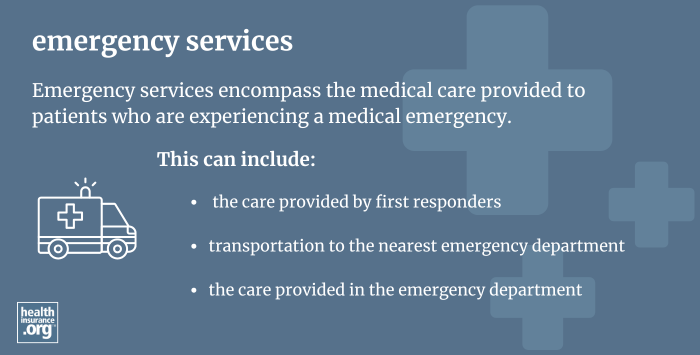
What are emergency services?
Emergency services encompass the medical care provided to patients who are experiencing a medical emergency. This can include, as needed, the care provided by first responders, transportation to the nearest emergency department, and the care provided in the emergency department.
Emergency services are one of the essential health benefits (EHBs) that must be covered by all individual and small-group health plans with effective dates of Jan. 1, 2014 or later.1
Emergency services differ from the other EHBs in that health plans cannot require prior authorization2 for emergency care, nor can they require that you receive the care at an in-network emergency department. The health plan cannot impose higher out-of-pocket costs (deductible, copays, and coinsurance) for out-of-network emergency services than it would impose for in-network emergency services.3
In addition, the No Surprises Act protects patients from surprise balance bills from out-of-network providers for most emergency services. This includes care provided in the emergency department as well as air ambulance services. However, patients can still receive balance bills from out-of-network ground ambulance providers,4 unless they have state-regulated coverage in a state that prohibits this.
Who provides emergency services?
Emergency services are provided by emergency medical technicians (EMTs), paramedics,5 and other pre-hospital clinicians,6 as well as emergency department staff. Emergency departments are typically part of a hospital, but there are also freestanding emergency departments.7
How emergency services coordinate with other services?
Emergency medical services (EMS) providers, including EMTs and paramedics, work together with various other entities, including law enforcement and fire departments.6
EMS providers also play a role in some community-based non-emergency care, including home visits to patients in underserved populations. In this role, EMS works together with primary care physicians and social services to prevent emergencies and improve patient outcomes.6
In addition, EMS providers can work with mental health professionals and local law enforcement to assist patients experiencing behavioral or mental health crises.6
Emergency services provided in an emergency room are often coordinated with the care provided by other medical providers. In 2021, more than 13% of all emergency department visits resulted in a hospital admission.8 And almost three-quarters of emergency department visits result in a referral to a non-emergency medical provider for follow-up care.9
Footnotes
- “Title 45 § 156.110 EHB-benchmark plan standards” Code of Federal Regulations. Accessed Mar. 4, 2025 ⤶
- “Prior authorization” HealthCare.gov. Accessed Mar. 14, 2025 ⤶
- “Using your health insurance coverage – Getting emergency care” HealthCare.gov. and “Know your rights when using health insurance” Centers for Medicare & Medicaid Services. Accessed Mar. 4, 2025 ⤶
- “Advisory Committee on Ground Ambulance and Patient Billing (GAPB)“ Centers for Medicare & Medicaid Services. Accessed Mar. 4, 2025 ⤶
- “What's the Difference Between an EMT and a Paramedic?" UCLA Center for Pre-Hospital Care. Accessed Oct. 6, 2025 ⤶
- “What is EMS?” EMS.gov. Accessed Mar. 4, 2025 ⤶ ⤶ ⤶ ⤶
- ”What is a Freestanding Emergency Department? Definitions Differ Across Major United States Data Sources” PubMed. April 16, 2020 ⤶
- “Emergency Department Visits” CDC National Center for Health Statistics. Accessed Mar. 5, 2025 ⤶
- “Characteristics of Emergency Department Patient Visits Referred for Follow-Up Medical Care After Discharge, National Hospital Ambulatory Medicare Care Survey—United States, 2018” PubMed. July 12, 2022 ⤶


